Auditing Theory and Practice: Risk, Ratios, and TCW Analysis
VerifiedAdded on 2023/06/07
|19
|4649
|473
Report
AI Summary
This report discusses various risks associated with auditing, focusing on challenges auditors face when recognizing material misstatements due to fraud or error. The most appropriate mechanism is the evaluation of business risk through the measurement of key financial ratios, which aids in performance evaluation. The analysis covers accounts receivables, investments, property assets, and marketing expenses for Trunkey Creek Wines (TCW). It assesses audit risks, recommends steps to reduce these risks, and examines operational efficiency and effectiveness of internal controls, complying with TCW's assurance objectives. Key ratios such as return on equity, return on production assets, gross margin, marketing cost over selling/administrative costs, times interest earned, days in inventory, and days in accounts receivables are analyzed to provide a comprehensive view of TCW's financial health and associated risks.
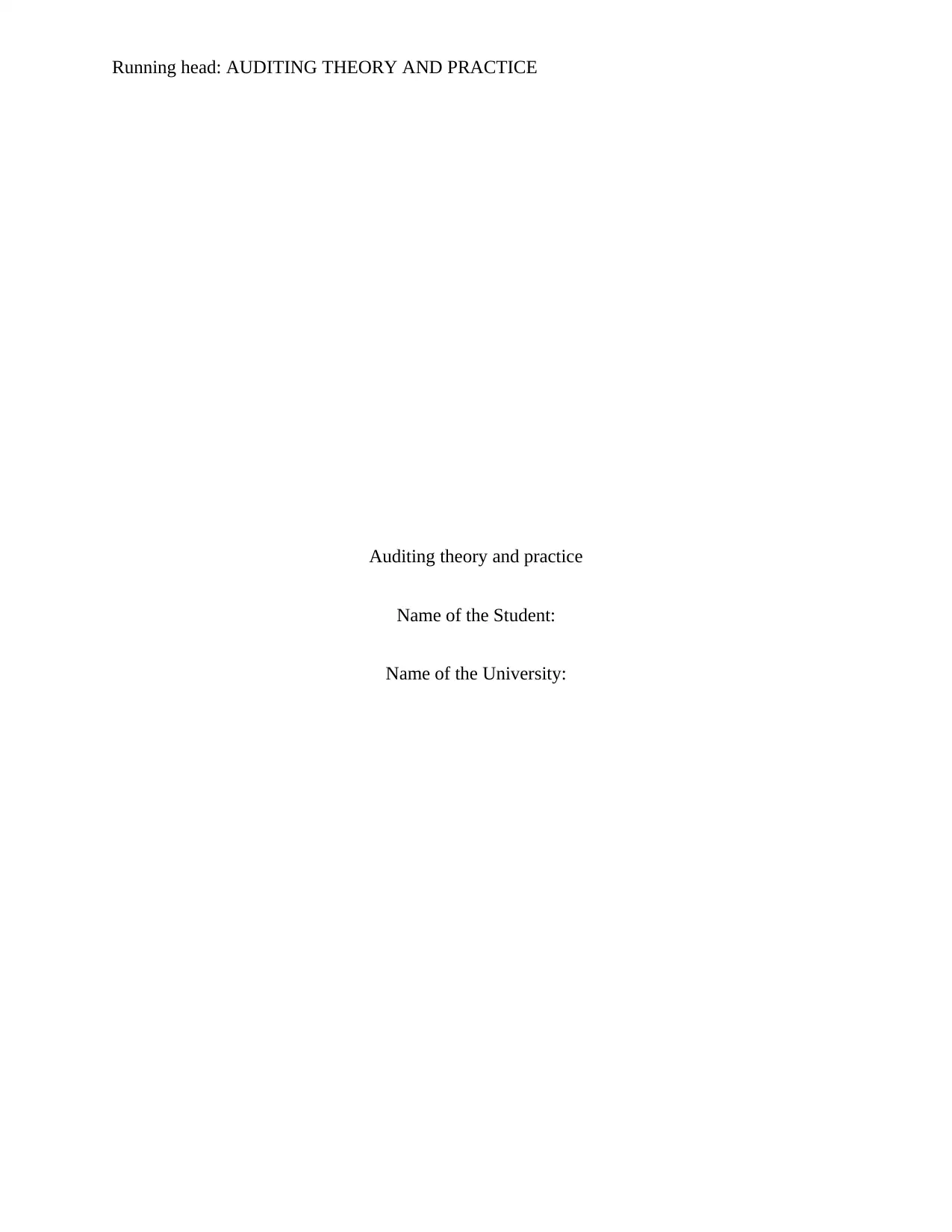
Running head: AUDITING THEORY AND PRACTICE
Auditing theory and practice
Name of the Student:
Name of the University:
Auditing theory and practice
Name of the Student:
Name of the University:
Paraphrase This Document
Need a fresh take? Get an instant paraphrase of this document with our AI Paraphraser
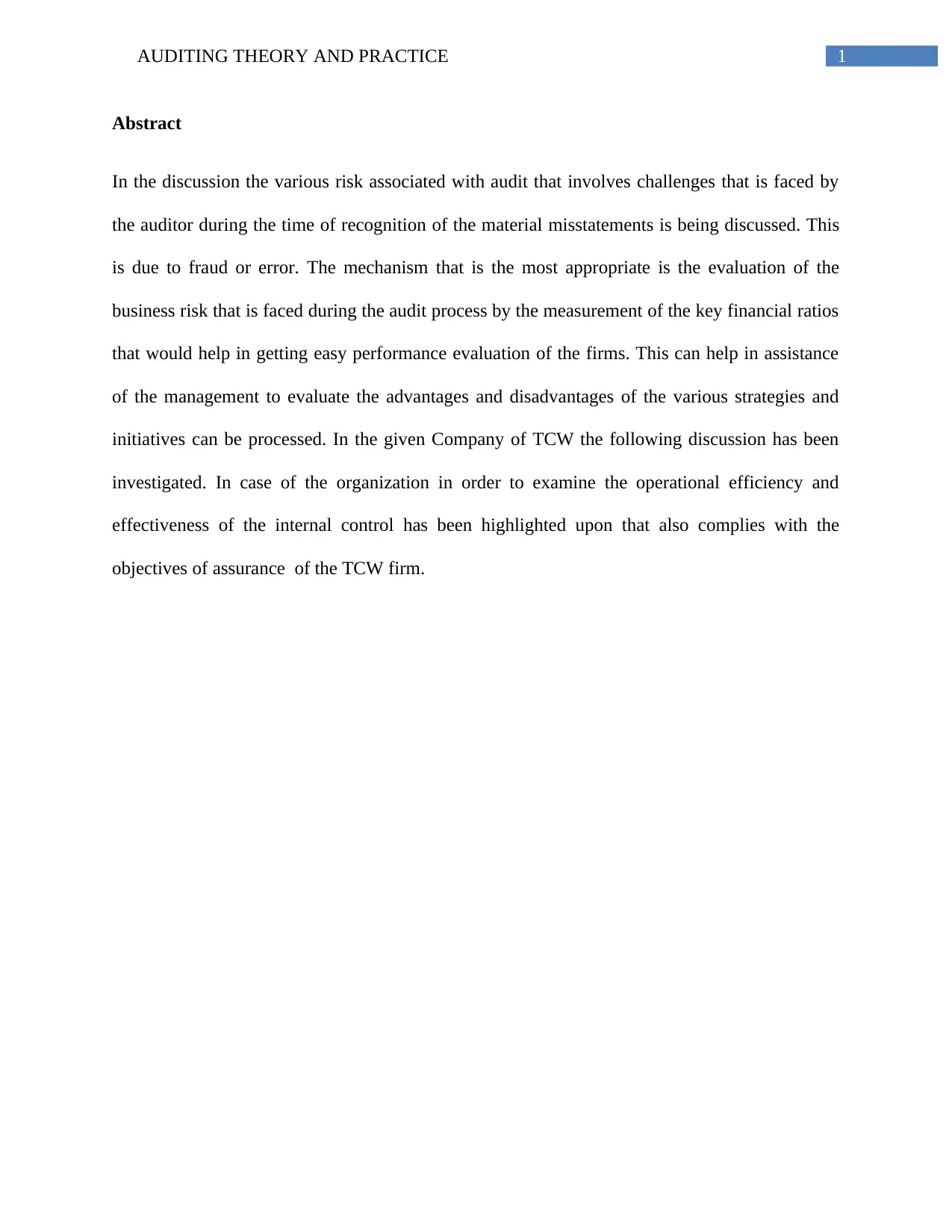
1AUDITING THEORY AND PRACTICE
Abstract
In the discussion the various risk associated with audit that involves challenges that is faced by
the auditor during the time of recognition of the material misstatements is being discussed. This
is due to fraud or error. The mechanism that is the most appropriate is the evaluation of the
business risk that is faced during the audit process by the measurement of the key financial ratios
that would help in getting easy performance evaluation of the firms. This can help in assistance
of the management to evaluate the advantages and disadvantages of the various strategies and
initiatives can be processed. In the given Company of TCW the following discussion has been
investigated. In case of the organization in order to examine the operational efficiency and
effectiveness of the internal control has been highlighted upon that also complies with the
objectives of assurance of the TCW firm.
Abstract
In the discussion the various risk associated with audit that involves challenges that is faced by
the auditor during the time of recognition of the material misstatements is being discussed. This
is due to fraud or error. The mechanism that is the most appropriate is the evaluation of the
business risk that is faced during the audit process by the measurement of the key financial ratios
that would help in getting easy performance evaluation of the firms. This can help in assistance
of the management to evaluate the advantages and disadvantages of the various strategies and
initiatives can be processed. In the given Company of TCW the following discussion has been
investigated. In case of the organization in order to examine the operational efficiency and
effectiveness of the internal control has been highlighted upon that also complies with the
objectives of assurance of the TCW firm.
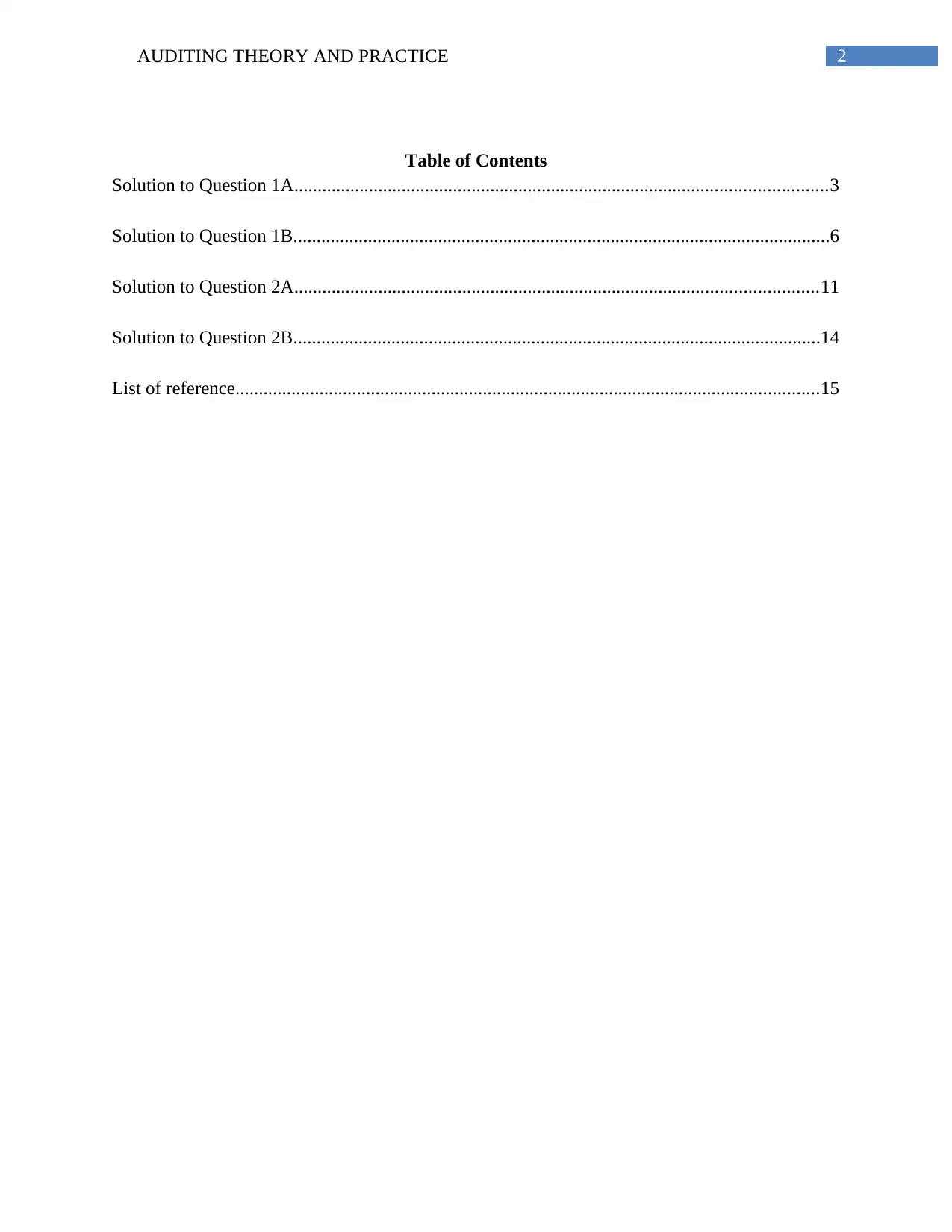
2AUDITING THEORY AND PRACTICE
Table of Contents
Solution to Question 1A..................................................................................................................3
Solution to Question 1B...................................................................................................................6
Solution to Question 2A................................................................................................................11
Solution to Question 2B.................................................................................................................14
List of reference.............................................................................................................................15
Table of Contents
Solution to Question 1A..................................................................................................................3
Solution to Question 1B...................................................................................................................6
Solution to Question 2A................................................................................................................11
Solution to Question 2B.................................................................................................................14
List of reference.............................................................................................................................15
⊘ This is a preview!⊘
Do you want full access?
Subscribe today to unlock all pages.

Trusted by 1+ million students worldwide
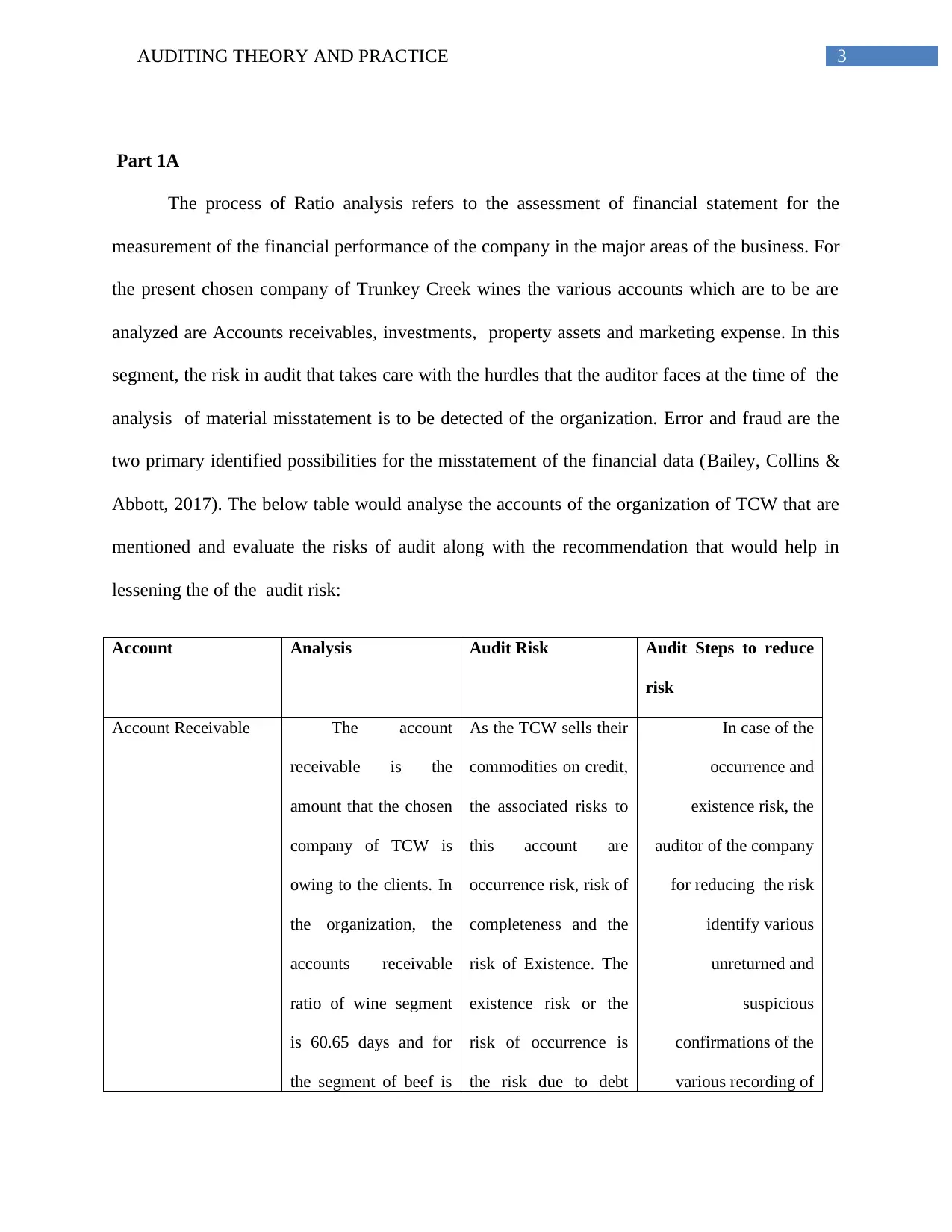
3AUDITING THEORY AND PRACTICE
Part 1A
The process of Ratio analysis refers to the assessment of financial statement for the
measurement of the financial performance of the company in the major areas of the business. For
the present chosen company of Trunkey Creek wines the various accounts which are to be are
analyzed are Accounts receivables, investments, property assets and marketing expense. In this
segment, the risk in audit that takes care with the hurdles that the auditor faces at the time of the
analysis of material misstatement is to be detected of the organization. Error and fraud are the
two primary identified possibilities for the misstatement of the financial data (Bailey, Collins &
Abbott, 2017). The below table would analyse the accounts of the organization of TCW that are
mentioned and evaluate the risks of audit along with the recommendation that would help in
lessening the of the audit risk:
Account Analysis Audit Risk Audit Steps to reduce
risk
Account Receivable The account
receivable is the
amount that the chosen
company of TCW is
owing to the clients. In
the organization, the
accounts receivable
ratio of wine segment
is 60.65 days and for
the segment of beef is
As the TCW sells their
commodities on credit,
the associated risks to
this account are
occurrence risk, risk of
completeness and the
risk of Existence. The
existence risk or the
risk of occurrence is
the risk due to debt
In case of the
occurrence and
existence risk, the
auditor of the company
for reducing the risk
identify various
unreturned and
suspicious
confirmations of the
various recording of
Part 1A
The process of Ratio analysis refers to the assessment of financial statement for the
measurement of the financial performance of the company in the major areas of the business. For
the present chosen company of Trunkey Creek wines the various accounts which are to be are
analyzed are Accounts receivables, investments, property assets and marketing expense. In this
segment, the risk in audit that takes care with the hurdles that the auditor faces at the time of the
analysis of material misstatement is to be detected of the organization. Error and fraud are the
two primary identified possibilities for the misstatement of the financial data (Bailey, Collins &
Abbott, 2017). The below table would analyse the accounts of the organization of TCW that are
mentioned and evaluate the risks of audit along with the recommendation that would help in
lessening the of the audit risk:
Account Analysis Audit Risk Audit Steps to reduce
risk
Account Receivable The account
receivable is the
amount that the chosen
company of TCW is
owing to the clients. In
the organization, the
accounts receivable
ratio of wine segment
is 60.65 days and for
the segment of beef is
As the TCW sells their
commodities on credit,
the associated risks to
this account are
occurrence risk, risk of
completeness and the
risk of Existence. The
existence risk or the
risk of occurrence is
the risk due to debt
In case of the
occurrence and
existence risk, the
auditor of the company
for reducing the risk
identify various
unreturned and
suspicious
confirmations of the
various recording of
Paraphrase This Document
Need a fresh take? Get an instant paraphrase of this document with our AI Paraphraser
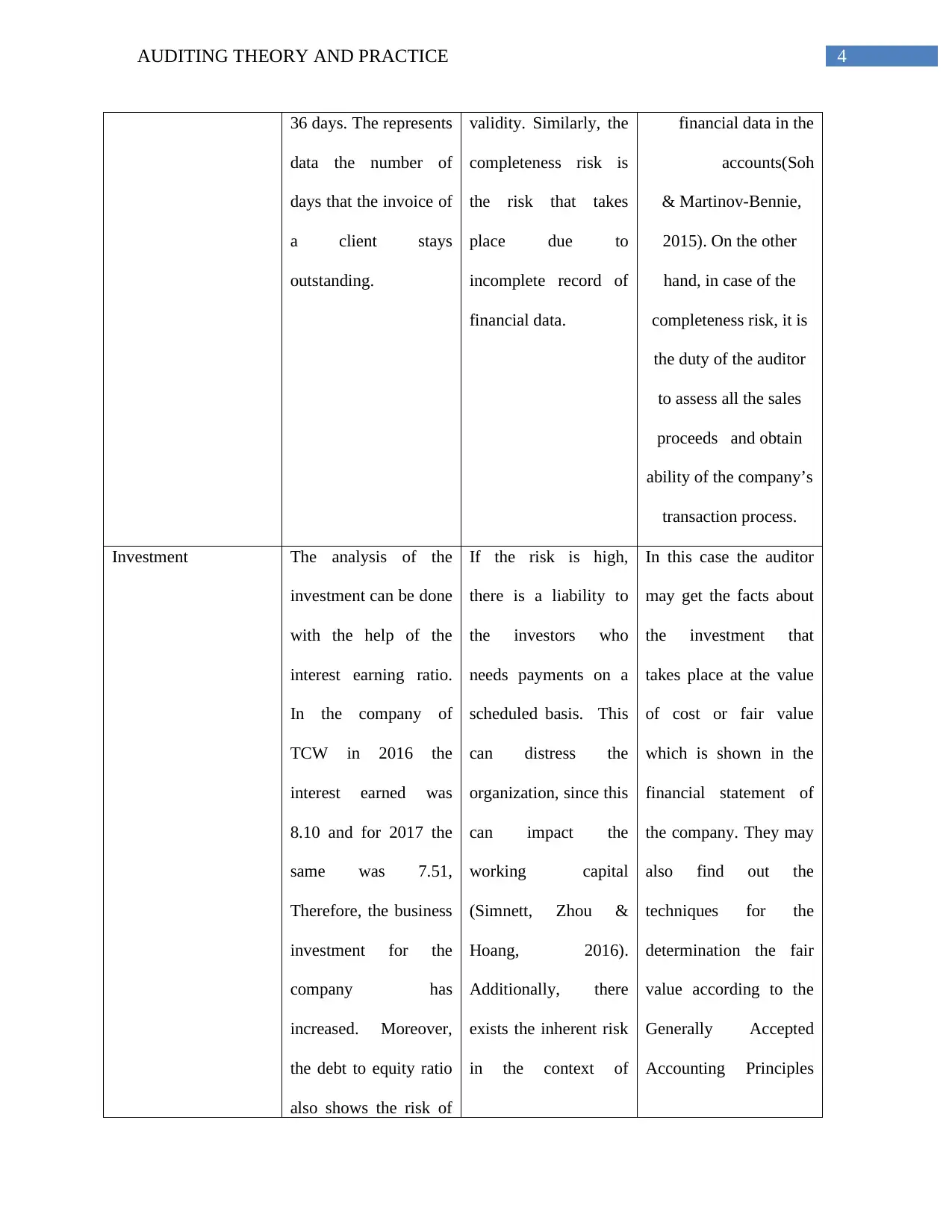
4AUDITING THEORY AND PRACTICE
36 days. The represents
data the number of
days that the invoice of
a client stays
outstanding.
validity. Similarly, the
completeness risk is
the risk that takes
place due to
incomplete record of
financial data.
financial data in the
accounts(Soh
& Martinov-Bennie,
2015). On the other
hand, in case of the
completeness risk, it is
the duty of the auditor
to assess all the sales
proceeds and obtain
ability of the company’s
transaction process.
Investment The analysis of the
investment can be done
with the help of the
interest earning ratio.
In the company of
TCW in 2016 the
interest earned was
8.10 and for 2017 the
same was 7.51,
Therefore, the business
investment for the
company has
increased. Moreover,
the debt to equity ratio
also shows the risk of
If the risk is high,
there is a liability to
the investors who
needs payments on a
scheduled basis. This
can distress the
organization, since this
can impact the
working capital
(Simnett, Zhou &
Hoang, 2016).
Additionally, there
exists the inherent risk
in the context of
In this case the auditor
may get the facts about
the investment that
takes place at the value
of cost or fair value
which is shown in the
financial statement of
the company. They may
also find out the
techniques for the
determination the fair
value according to the
Generally Accepted
Accounting Principles
36 days. The represents
data the number of
days that the invoice of
a client stays
outstanding.
validity. Similarly, the
completeness risk is
the risk that takes
place due to
incomplete record of
financial data.
financial data in the
accounts(Soh
& Martinov-Bennie,
2015). On the other
hand, in case of the
completeness risk, it is
the duty of the auditor
to assess all the sales
proceeds and obtain
ability of the company’s
transaction process.
Investment The analysis of the
investment can be done
with the help of the
interest earning ratio.
In the company of
TCW in 2016 the
interest earned was
8.10 and for 2017 the
same was 7.51,
Therefore, the business
investment for the
company has
increased. Moreover,
the debt to equity ratio
also shows the risk of
If the risk is high,
there is a liability to
the investors who
needs payments on a
scheduled basis. This
can distress the
organization, since this
can impact the
working capital
(Simnett, Zhou &
Hoang, 2016).
Additionally, there
exists the inherent risk
in the context of
In this case the auditor
may get the facts about
the investment that
takes place at the value
of cost or fair value
which is shown in the
financial statement of
the company. They may
also find out the
techniques for the
determination the fair
value according to the
Generally Accepted
Accounting Principles
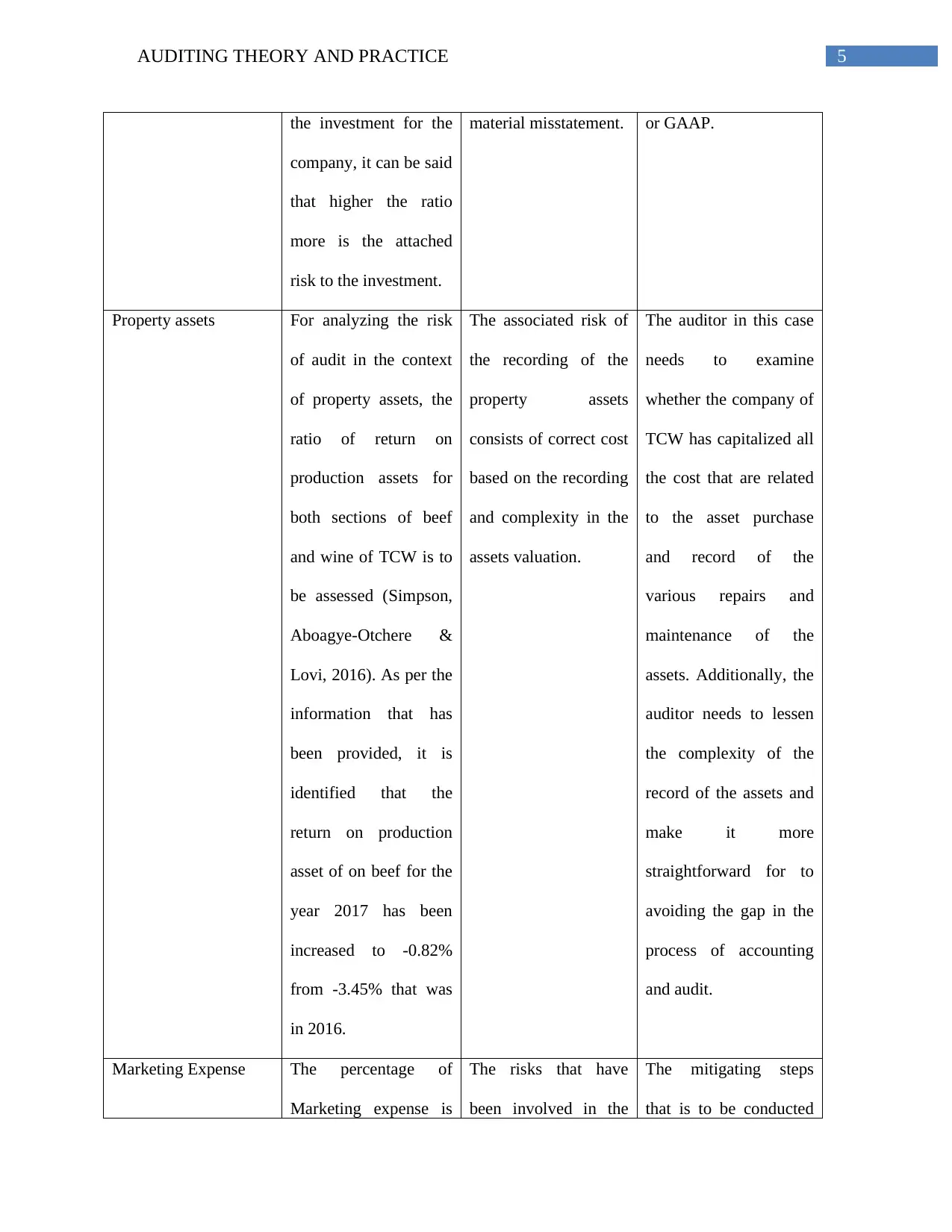
5AUDITING THEORY AND PRACTICE
the investment for the
company, it can be said
that higher the ratio
more is the attached
risk to the investment.
material misstatement. or GAAP.
Property assets For analyzing the risk
of audit in the context
of property assets, the
ratio of return on
production assets for
both sections of beef
and wine of TCW is to
be assessed (Simpson,
Aboagye-Otchere &
Lovi, 2016). As per the
information that has
been provided, it is
identified that the
return on production
asset of on beef for the
year 2017 has been
increased to -0.82%
from -3.45% that was
in 2016.
The associated risk of
the recording of the
property assets
consists of correct cost
based on the recording
and complexity in the
assets valuation.
The auditor in this case
needs to examine
whether the company of
TCW has capitalized all
the cost that are related
to the asset purchase
and record of the
various repairs and
maintenance of the
assets. Additionally, the
auditor needs to lessen
the complexity of the
record of the assets and
make it more
straightforward for to
avoiding the gap in the
process of accounting
and audit.
Marketing Expense The percentage of
Marketing expense is
The risks that have
been involved in the
The mitigating steps
that is to be conducted
the investment for the
company, it can be said
that higher the ratio
more is the attached
risk to the investment.
material misstatement. or GAAP.
Property assets For analyzing the risk
of audit in the context
of property assets, the
ratio of return on
production assets for
both sections of beef
and wine of TCW is to
be assessed (Simpson,
Aboagye-Otchere &
Lovi, 2016). As per the
information that has
been provided, it is
identified that the
return on production
asset of on beef for the
year 2017 has been
increased to -0.82%
from -3.45% that was
in 2016.
The associated risk of
the recording of the
property assets
consists of correct cost
based on the recording
and complexity in the
assets valuation.
The auditor in this case
needs to examine
whether the company of
TCW has capitalized all
the cost that are related
to the asset purchase
and record of the
various repairs and
maintenance of the
assets. Additionally, the
auditor needs to lessen
the complexity of the
record of the assets and
make it more
straightforward for to
avoiding the gap in the
process of accounting
and audit.
Marketing Expense The percentage of
Marketing expense is
The risks that have
been involved in the
The mitigating steps
that is to be conducted
⊘ This is a preview!⊘
Do you want full access?
Subscribe today to unlock all pages.

Trusted by 1+ million students worldwide
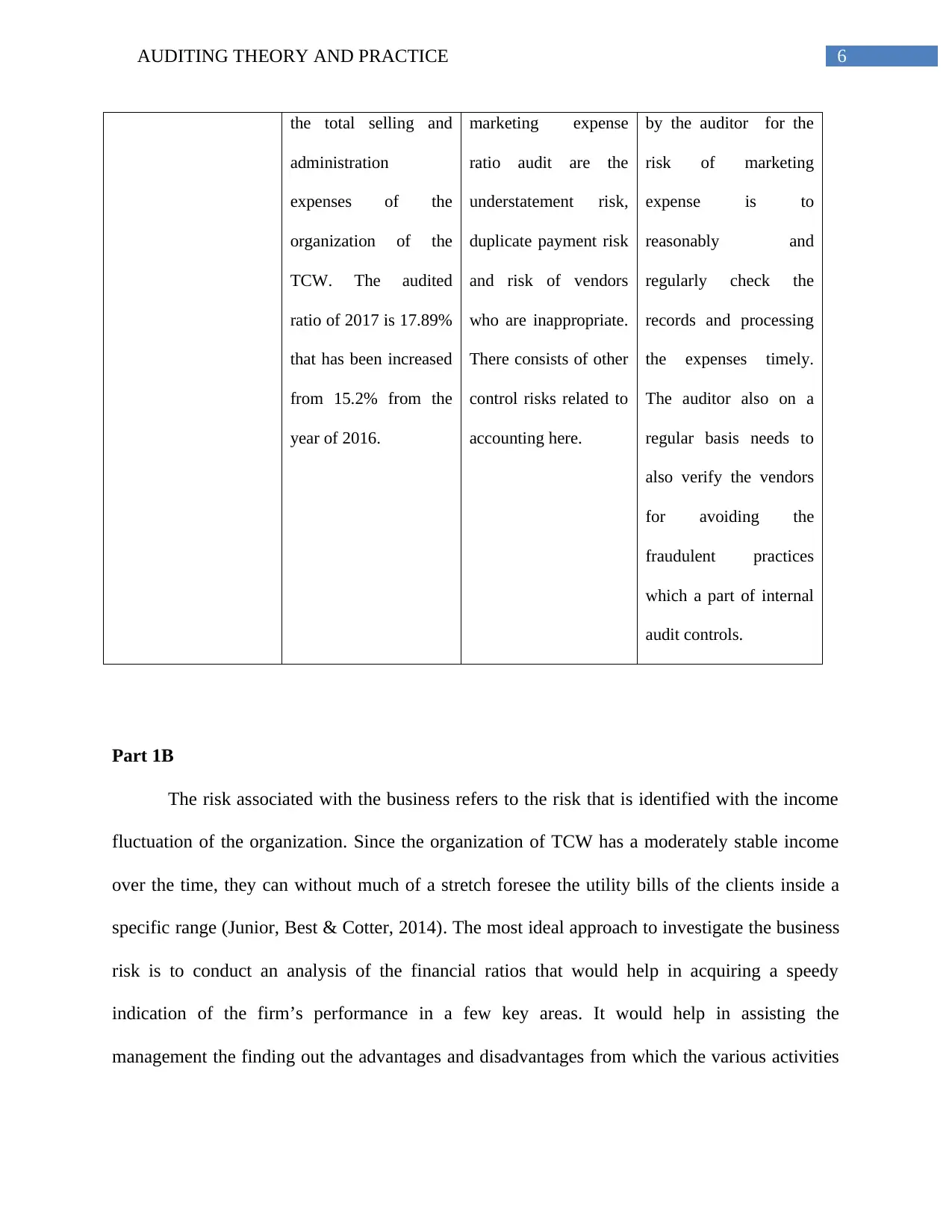
6AUDITING THEORY AND PRACTICE
the total selling and
administration
expenses of the
organization of the
TCW. The audited
ratio of 2017 is 17.89%
that has been increased
from 15.2% from the
year of 2016.
marketing expense
ratio audit are the
understatement risk,
duplicate payment risk
and risk of vendors
who are inappropriate.
There consists of other
control risks related to
accounting here.
by the auditor for the
risk of marketing
expense is to
reasonably and
regularly check the
records and processing
the expenses timely.
The auditor also on a
regular basis needs to
also verify the vendors
for avoiding the
fraudulent practices
which a part of internal
audit controls.
Part 1B
The risk associated with the business refers to the risk that is identified with the income
fluctuation of the organization. Since the organization of TCW has a moderately stable income
over the time, they can without much of a stretch foresee the utility bills of the clients inside a
specific range (Junior, Best & Cotter, 2014). The most ideal approach to investigate the business
risk is to conduct an analysis of the financial ratios that would help in acquiring a speedy
indication of the firm’s performance in a few key areas. It would help in assisting the
management the finding out the advantages and disadvantages from which the various activities
the total selling and
administration
expenses of the
organization of the
TCW. The audited
ratio of 2017 is 17.89%
that has been increased
from 15.2% from the
year of 2016.
marketing expense
ratio audit are the
understatement risk,
duplicate payment risk
and risk of vendors
who are inappropriate.
There consists of other
control risks related to
accounting here.
by the auditor for the
risk of marketing
expense is to
reasonably and
regularly check the
records and processing
the expenses timely.
The auditor also on a
regular basis needs to
also verify the vendors
for avoiding the
fraudulent practices
which a part of internal
audit controls.
Part 1B
The risk associated with the business refers to the risk that is identified with the income
fluctuation of the organization. Since the organization of TCW has a moderately stable income
over the time, they can without much of a stretch foresee the utility bills of the clients inside a
specific range (Junior, Best & Cotter, 2014). The most ideal approach to investigate the business
risk is to conduct an analysis of the financial ratios that would help in acquiring a speedy
indication of the firm’s performance in a few key areas. It would help in assisting the
management the finding out the advantages and disadvantages from which the various activities
Paraphrase This Document
Need a fresh take? Get an instant paraphrase of this document with our AI Paraphraser
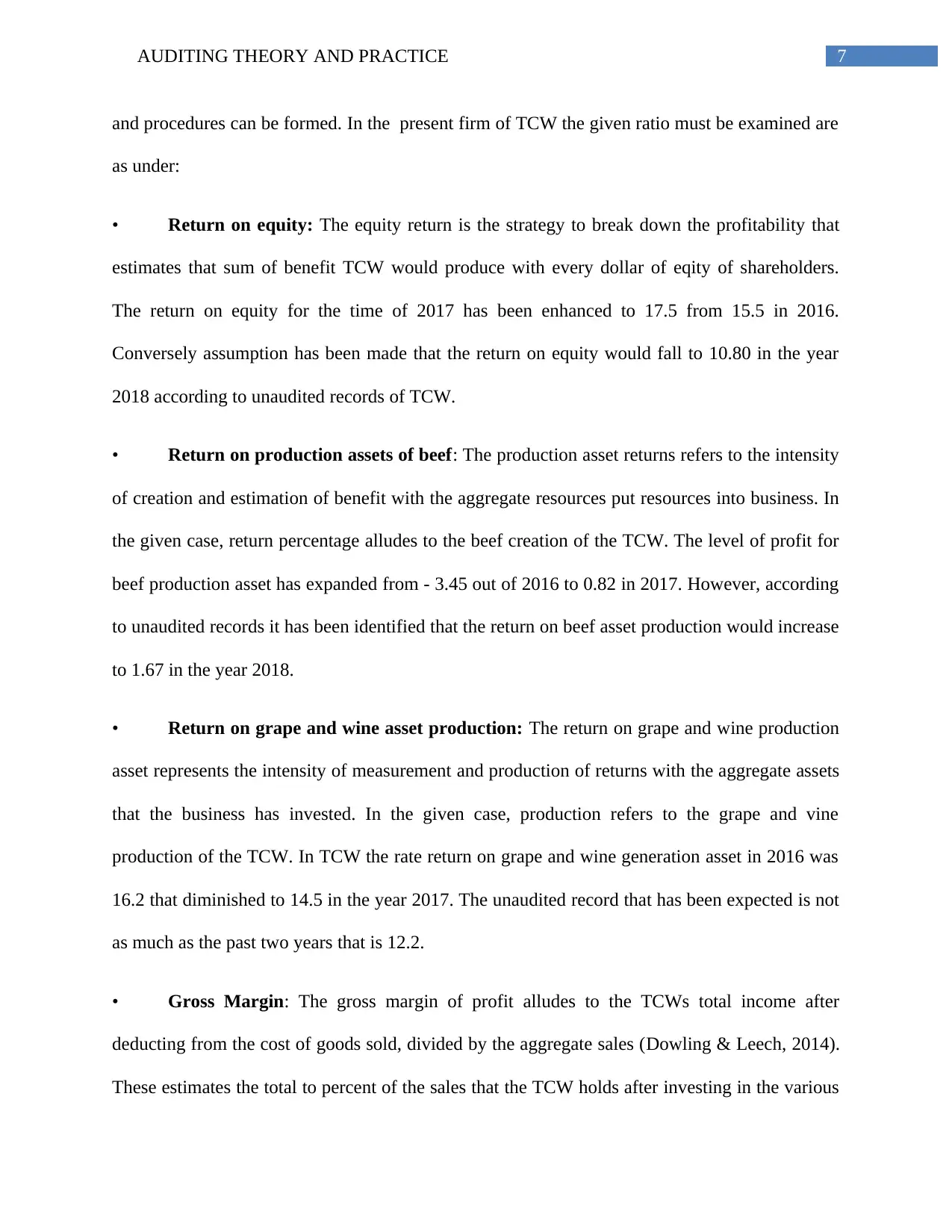
7AUDITING THEORY AND PRACTICE
and procedures can be formed. In the present firm of TCW the given ratio must be examined are
as under:
• Return on equity: The equity return is the strategy to break down the profitability that
estimates that sum of benefit TCW would produce with every dollar of eqity of shareholders.
The return on equity for the time of 2017 has been enhanced to 17.5 from 15.5 in 2016.
Conversely assumption has been made that the return on equity would fall to 10.80 in the year
2018 according to unaudited records of TCW.
• Return on production assets of beef: The production asset returns refers to the intensity
of creation and estimation of benefit with the aggregate resources put resources into business. In
the given case, return percentage alludes to the beef creation of the TCW. The level of profit for
beef production asset has expanded from - 3.45 out of 2016 to 0.82 in 2017. However, according
to unaudited records it has been identified that the return on beef asset production would increase
to 1.67 in the year 2018.
• Return on grape and wine asset production: The return on grape and wine production
asset represents the intensity of measurement and production of returns with the aggregate assets
that the business has invested. In the given case, production refers to the grape and vine
production of the TCW. In TCW the rate return on grape and wine generation asset in 2016 was
16.2 that diminished to 14.5 in the year 2017. The unaudited record that has been expected is not
as much as the past two years that is 12.2.
• Gross Margin: The gross margin of profit alludes to the TCWs total income after
deducting from the cost of goods sold, divided by the aggregate sales (Dowling & Leech, 2014).
These estimates the total to percent of the sales that the TCW holds after investing in the various
and procedures can be formed. In the present firm of TCW the given ratio must be examined are
as under:
• Return on equity: The equity return is the strategy to break down the profitability that
estimates that sum of benefit TCW would produce with every dollar of eqity of shareholders.
The return on equity for the time of 2017 has been enhanced to 17.5 from 15.5 in 2016.
Conversely assumption has been made that the return on equity would fall to 10.80 in the year
2018 according to unaudited records of TCW.
• Return on production assets of beef: The production asset returns refers to the intensity
of creation and estimation of benefit with the aggregate resources put resources into business. In
the given case, return percentage alludes to the beef creation of the TCW. The level of profit for
beef production asset has expanded from - 3.45 out of 2016 to 0.82 in 2017. However, according
to unaudited records it has been identified that the return on beef asset production would increase
to 1.67 in the year 2018.
• Return on grape and wine asset production: The return on grape and wine production
asset represents the intensity of measurement and production of returns with the aggregate assets
that the business has invested. In the given case, production refers to the grape and vine
production of the TCW. In TCW the rate return on grape and wine generation asset in 2016 was
16.2 that diminished to 14.5 in the year 2017. The unaudited record that has been expected is not
as much as the past two years that is 12.2.
• Gross Margin: The gross margin of profit alludes to the TCWs total income after
deducting from the cost of goods sold, divided by the aggregate sales (Dowling & Leech, 2014).
These estimates the total to percent of the sales that the TCW holds after investing in the various
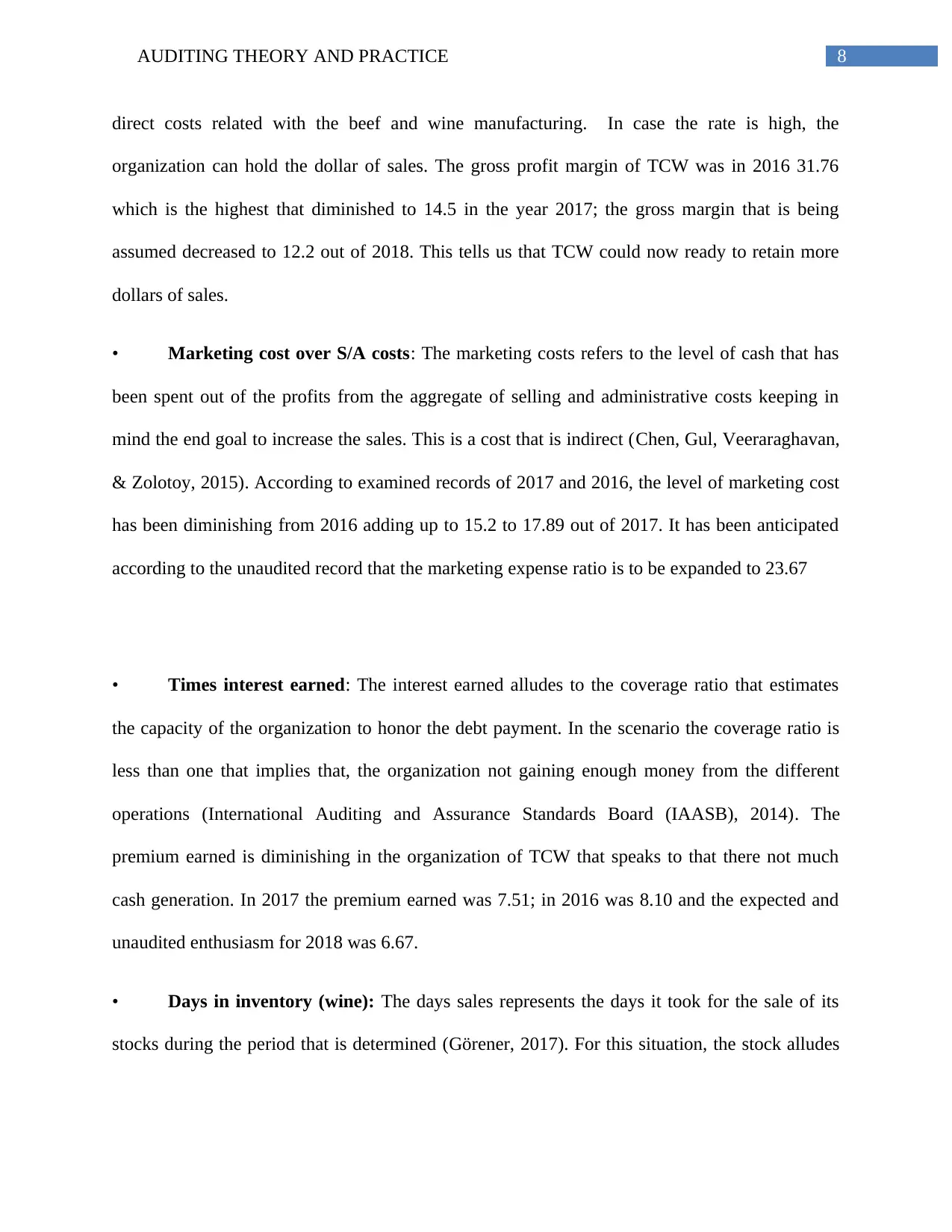
8AUDITING THEORY AND PRACTICE
direct costs related with the beef and wine manufacturing. In case the rate is high, the
organization can hold the dollar of sales. The gross profit margin of TCW was in 2016 31.76
which is the highest that diminished to 14.5 in the year 2017; the gross margin that is being
assumed decreased to 12.2 out of 2018. This tells us that TCW could now ready to retain more
dollars of sales.
• Marketing cost over S/A costs: The marketing costs refers to the level of cash that has
been spent out of the profits from the aggregate of selling and administrative costs keeping in
mind the end goal to increase the sales. This is a cost that is indirect (Chen, Gul, Veeraraghavan,
& Zolotoy, 2015). According to examined records of 2017 and 2016, the level of marketing cost
has been diminishing from 2016 adding up to 15.2 to 17.89 out of 2017. It has been anticipated
according to the unaudited record that the marketing expense ratio is to be expanded to 23.67
• Times interest earned: The interest earned alludes to the coverage ratio that estimates
the capacity of the organization to honor the debt payment. In the scenario the coverage ratio is
less than one that implies that, the organization not gaining enough money from the different
operations (International Auditing and Assurance Standards Board (IAASB), 2014). The
premium earned is diminishing in the organization of TCW that speaks to that there not much
cash generation. In 2017 the premium earned was 7.51; in 2016 was 8.10 and the expected and
unaudited enthusiasm for 2018 was 6.67.
• Days in inventory (wine): The days sales represents the days it took for the sale of its
stocks during the period that is determined (Görener, 2017). For this situation, the stock alludes
direct costs related with the beef and wine manufacturing. In case the rate is high, the
organization can hold the dollar of sales. The gross profit margin of TCW was in 2016 31.76
which is the highest that diminished to 14.5 in the year 2017; the gross margin that is being
assumed decreased to 12.2 out of 2018. This tells us that TCW could now ready to retain more
dollars of sales.
• Marketing cost over S/A costs: The marketing costs refers to the level of cash that has
been spent out of the profits from the aggregate of selling and administrative costs keeping in
mind the end goal to increase the sales. This is a cost that is indirect (Chen, Gul, Veeraraghavan,
& Zolotoy, 2015). According to examined records of 2017 and 2016, the level of marketing cost
has been diminishing from 2016 adding up to 15.2 to 17.89 out of 2017. It has been anticipated
according to the unaudited record that the marketing expense ratio is to be expanded to 23.67
• Times interest earned: The interest earned alludes to the coverage ratio that estimates
the capacity of the organization to honor the debt payment. In the scenario the coverage ratio is
less than one that implies that, the organization not gaining enough money from the different
operations (International Auditing and Assurance Standards Board (IAASB), 2014). The
premium earned is diminishing in the organization of TCW that speaks to that there not much
cash generation. In 2017 the premium earned was 7.51; in 2016 was 8.10 and the expected and
unaudited enthusiasm for 2018 was 6.67.
• Days in inventory (wine): The days sales represents the days it took for the sale of its
stocks during the period that is determined (Görener, 2017). For this situation, the stock alludes
⊘ This is a preview!⊘
Do you want full access?
Subscribe today to unlock all pages.

Trusted by 1+ million students worldwide
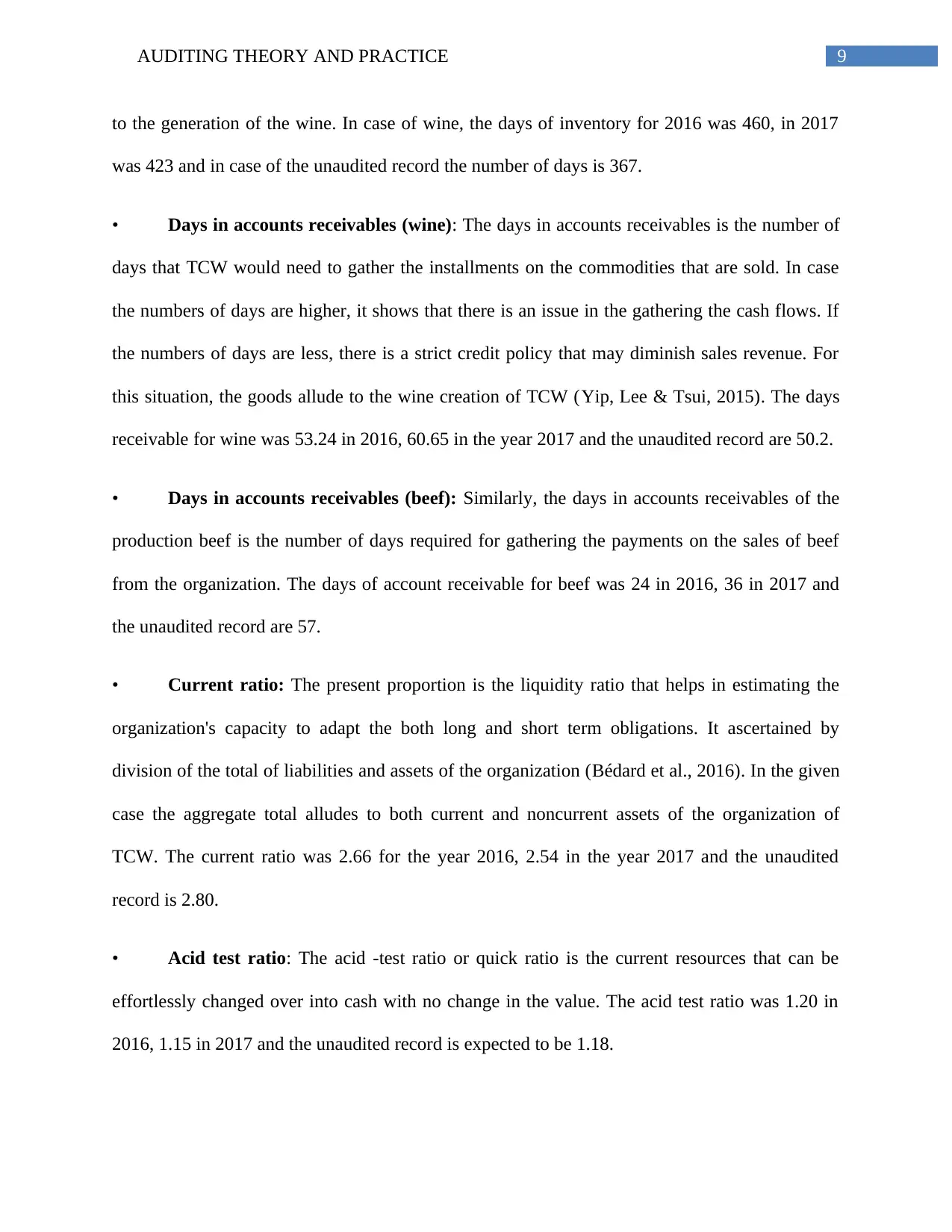
9AUDITING THEORY AND PRACTICE
to the generation of the wine. In case of wine, the days of inventory for 2016 was 460, in 2017
was 423 and in case of the unaudited record the number of days is 367.
• Days in accounts receivables (wine): The days in accounts receivables is the number of
days that TCW would need to gather the installments on the commodities that are sold. In case
the numbers of days are higher, it shows that there is an issue in the gathering the cash flows. If
the numbers of days are less, there is a strict credit policy that may diminish sales revenue. For
this situation, the goods allude to the wine creation of TCW (Yip, Lee & Tsui, 2015). The days
receivable for wine was 53.24 in 2016, 60.65 in the year 2017 and the unaudited record are 50.2.
• Days in accounts receivables (beef): Similarly, the days in accounts receivables of the
production beef is the number of days required for gathering the payments on the sales of beef
from the organization. The days of account receivable for beef was 24 in 2016, 36 in 2017 and
the unaudited record are 57.
• Current ratio: The present proportion is the liquidity ratio that helps in estimating the
organization's capacity to adapt the both long and short term obligations. It ascertained by
division of the total of liabilities and assets of the organization (Bédard et al., 2016). In the given
case the aggregate total alludes to both current and noncurrent assets of the organization of
TCW. The current ratio was 2.66 for the year 2016, 2.54 in the year 2017 and the unaudited
record is 2.80.
• Acid test ratio: The acid -test ratio or quick ratio is the current resources that can be
effortlessly changed over into cash with no change in the value. The acid test ratio was 1.20 in
2016, 1.15 in 2017 and the unaudited record is expected to be 1.18.
to the generation of the wine. In case of wine, the days of inventory for 2016 was 460, in 2017
was 423 and in case of the unaudited record the number of days is 367.
• Days in accounts receivables (wine): The days in accounts receivables is the number of
days that TCW would need to gather the installments on the commodities that are sold. In case
the numbers of days are higher, it shows that there is an issue in the gathering the cash flows. If
the numbers of days are less, there is a strict credit policy that may diminish sales revenue. For
this situation, the goods allude to the wine creation of TCW (Yip, Lee & Tsui, 2015). The days
receivable for wine was 53.24 in 2016, 60.65 in the year 2017 and the unaudited record are 50.2.
• Days in accounts receivables (beef): Similarly, the days in accounts receivables of the
production beef is the number of days required for gathering the payments on the sales of beef
from the organization. The days of account receivable for beef was 24 in 2016, 36 in 2017 and
the unaudited record are 57.
• Current ratio: The present proportion is the liquidity ratio that helps in estimating the
organization's capacity to adapt the both long and short term obligations. It ascertained by
division of the total of liabilities and assets of the organization (Bédard et al., 2016). In the given
case the aggregate total alludes to both current and noncurrent assets of the organization of
TCW. The current ratio was 2.66 for the year 2016, 2.54 in the year 2017 and the unaudited
record is 2.80.
• Acid test ratio: The acid -test ratio or quick ratio is the current resources that can be
effortlessly changed over into cash with no change in the value. The acid test ratio was 1.20 in
2016, 1.15 in 2017 and the unaudited record is expected to be 1.18.
Paraphrase This Document
Need a fresh take? Get an instant paraphrase of this document with our AI Paraphraser
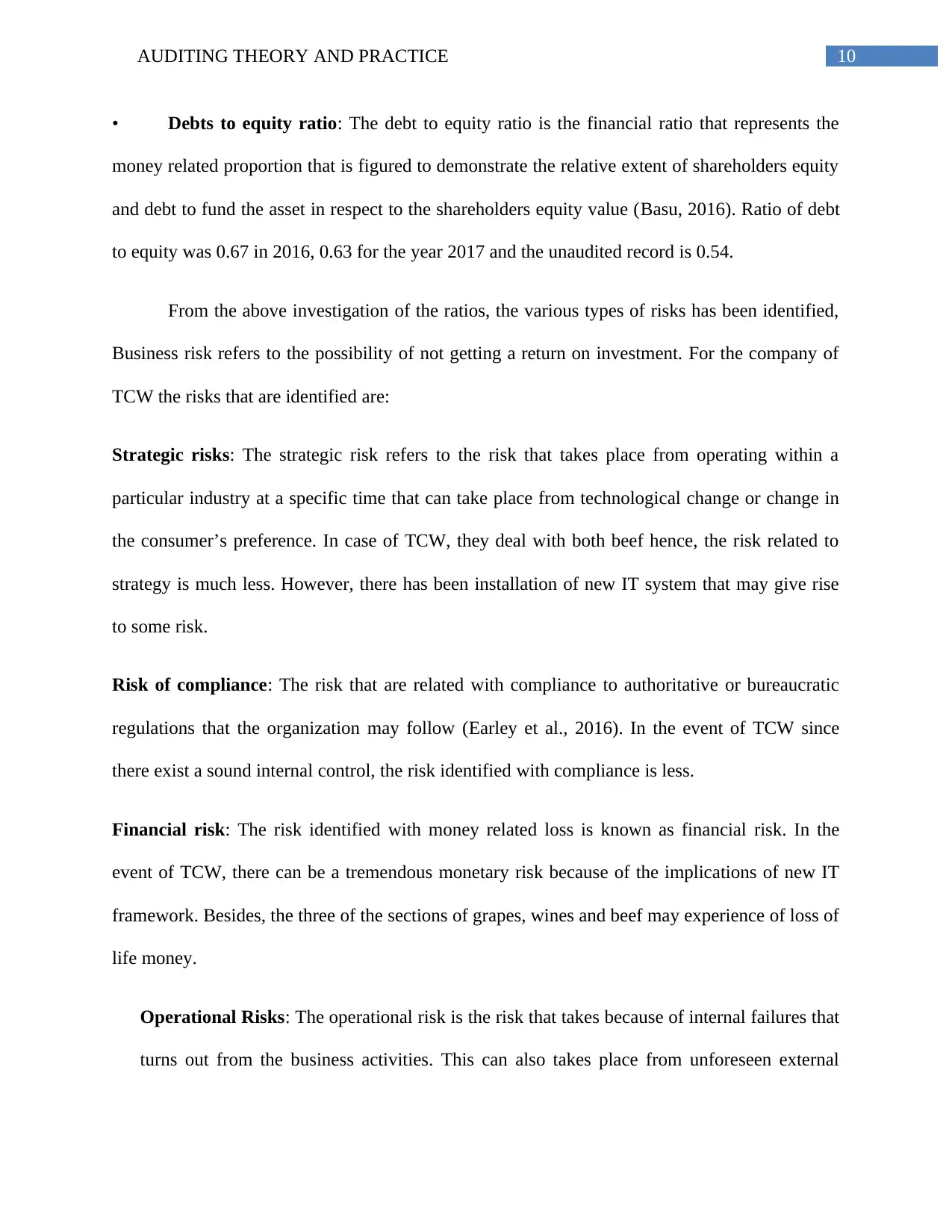
10AUDITING THEORY AND PRACTICE
• Debts to equity ratio: The debt to equity ratio is the financial ratio that represents the
money related proportion that is figured to demonstrate the relative extent of shareholders equity
and debt to fund the asset in respect to the shareholders equity value (Basu, 2016). Ratio of debt
to equity was 0.67 in 2016, 0.63 for the year 2017 and the unaudited record is 0.54.
From the above investigation of the ratios, the various types of risks has been identified,
Business risk refers to the possibility of not getting a return on investment. For the company of
TCW the risks that are identified are:
Strategic risks: The strategic risk refers to the risk that takes place from operating within a
particular industry at a specific time that can take place from technological change or change in
the consumer’s preference. In case of TCW, they deal with both beef hence, the risk related to
strategy is much less. However, there has been installation of new IT system that may give rise
to some risk.
Risk of compliance: The risk that are related with compliance to authoritative or bureaucratic
regulations that the organization may follow (Earley et al., 2016). In the event of TCW since
there exist a sound internal control, the risk identified with compliance is less.
Financial risk: The risk identified with money related loss is known as financial risk. In the
event of TCW, there can be a tremendous monetary risk because of the implications of new IT
framework. Besides, the three of the sections of grapes, wines and beef may experience of loss of
life money.
Operational Risks: The operational risk is the risk that takes because of internal failures that
turns out from the business activities. This can also takes place from unforeseen external
• Debts to equity ratio: The debt to equity ratio is the financial ratio that represents the
money related proportion that is figured to demonstrate the relative extent of shareholders equity
and debt to fund the asset in respect to the shareholders equity value (Basu, 2016). Ratio of debt
to equity was 0.67 in 2016, 0.63 for the year 2017 and the unaudited record is 0.54.
From the above investigation of the ratios, the various types of risks has been identified,
Business risk refers to the possibility of not getting a return on investment. For the company of
TCW the risks that are identified are:
Strategic risks: The strategic risk refers to the risk that takes place from operating within a
particular industry at a specific time that can take place from technological change or change in
the consumer’s preference. In case of TCW, they deal with both beef hence, the risk related to
strategy is much less. However, there has been installation of new IT system that may give rise
to some risk.
Risk of compliance: The risk that are related with compliance to authoritative or bureaucratic
regulations that the organization may follow (Earley et al., 2016). In the event of TCW since
there exist a sound internal control, the risk identified with compliance is less.
Financial risk: The risk identified with money related loss is known as financial risk. In the
event of TCW, there can be a tremendous monetary risk because of the implications of new IT
framework. Besides, the three of the sections of grapes, wines and beef may experience of loss of
life money.
Operational Risks: The operational risk is the risk that takes because of internal failures that
turns out from the business activities. This can also takes place from unforeseen external
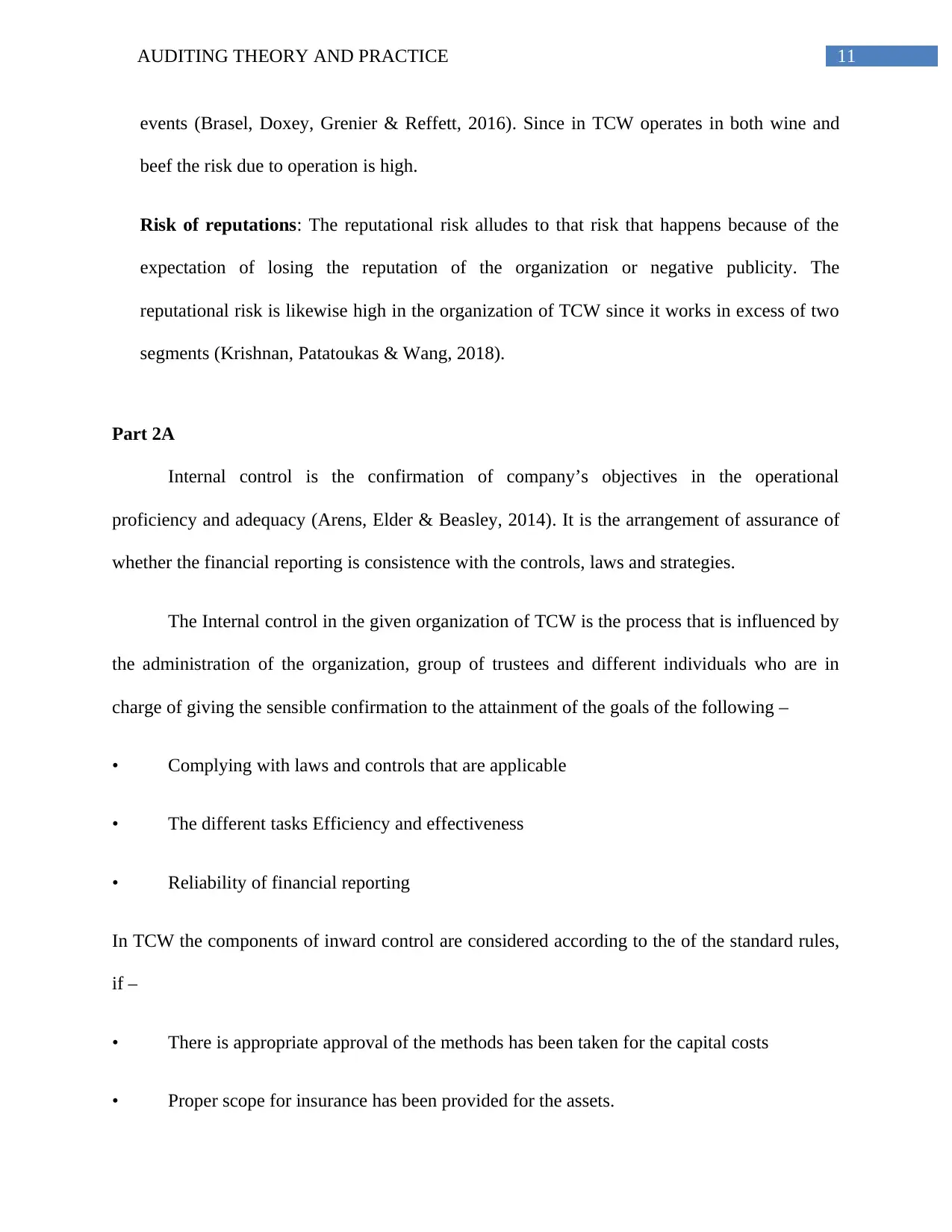
11AUDITING THEORY AND PRACTICE
events (Brasel, Doxey, Grenier & Reffett, 2016). Since in TCW operates in both wine and
beef the risk due to operation is high.
Risk of reputations: The reputational risk alludes to that risk that happens because of the
expectation of losing the reputation of the organization or negative publicity. The
reputational risk is likewise high in the organization of TCW since it works in excess of two
segments (Krishnan, Patatoukas & Wang, 2018).
Part 2A
Internal control is the confirmation of company’s objectives in the operational
proficiency and adequacy (Arens, Elder & Beasley, 2014). It is the arrangement of assurance of
whether the financial reporting is consistence with the controls, laws and strategies.
The Internal control in the given organization of TCW is the process that is influenced by
the administration of the organization, group of trustees and different individuals who are in
charge of giving the sensible confirmation to the attainment of the goals of the following –
• Complying with laws and controls that are applicable
• The different tasks Efficiency and effectiveness
• Reliability of financial reporting
In TCW the components of inward control are considered according to the of the standard rules,
if –
• There is appropriate approval of the methods has been taken for the capital costs
• Proper scope for insurance has been provided for the assets.
events (Brasel, Doxey, Grenier & Reffett, 2016). Since in TCW operates in both wine and
beef the risk due to operation is high.
Risk of reputations: The reputational risk alludes to that risk that happens because of the
expectation of losing the reputation of the organization or negative publicity. The
reputational risk is likewise high in the organization of TCW since it works in excess of two
segments (Krishnan, Patatoukas & Wang, 2018).
Part 2A
Internal control is the confirmation of company’s objectives in the operational
proficiency and adequacy (Arens, Elder & Beasley, 2014). It is the arrangement of assurance of
whether the financial reporting is consistence with the controls, laws and strategies.
The Internal control in the given organization of TCW is the process that is influenced by
the administration of the organization, group of trustees and different individuals who are in
charge of giving the sensible confirmation to the attainment of the goals of the following –
• Complying with laws and controls that are applicable
• The different tasks Efficiency and effectiveness
• Reliability of financial reporting
In TCW the components of inward control are considered according to the of the standard rules,
if –
• There is appropriate approval of the methods has been taken for the capital costs
• Proper scope for insurance has been provided for the assets.
⊘ This is a preview!⊘
Do you want full access?
Subscribe today to unlock all pages.

Trusted by 1+ million students worldwide
1 out of 19
Related Documents
Your All-in-One AI-Powered Toolkit for Academic Success.
+13062052269
info@desklib.com
Available 24*7 on WhatsApp / Email
![[object Object]](/_next/static/media/star-bottom.7253800d.svg)
Unlock your academic potential
Copyright © 2020–2025 A2Z Services. All Rights Reserved. Developed and managed by ZUCOL.




